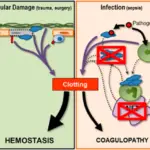
Gross and microscopic lesions in naturally PRV-infected dogs. A: Heart, showing ecchymoses in the epicardium; B: heart, showing an ecchymosis in the papillary muscle of the left ventricle (LV, left ventricle; MV, mitral valves); C: heart, showing focal hemorrhage (arrows) in the mitral valves (LV, left ventricle; MV, mitral valves); D: lung, focal hemorrhage; E: stomach, diffuse deep-red discoloration of the gastric mucosa as a consequence of congestion and hemorrhage; F: spleen, numerous dark-red to black, raised, soft, blood-filled areas of various sizes are incompletely contracted areas; G: thymus, evident hemorrhage; H: brainstem, showing perivascular cuffing around a small blood vessel (HE); I: hyperplasia of glial cells (HE); J: cardiac muscle, vertical section, in which the parallel arrays of myofibers are disrupted by fibrin and erythrocytes; note the myocardial fiber degeneration, necrosis with hypereosinophilia, and loss of cross-striations (HE); K: lung, hemorrhage and exudation in the lung (HE); L: brainstem, immunohistochemical detection of PRV antigen in the brainstem. DAB was used as the chromogen. Pathogenesis of natural and experimental Pseudorabies virus infections in dogs. Zhang L, Zhong C, Wang J, Lu Z, Liu L, Yang W, Lyu Y - Virology journal (2015)
Ecchymoses are purple flat patches on the skin that are commonly known as bruises.
What is the Pathology of Ecchymoses?
The pathology of ecchymoses is:
-Etiology: The cause of ecchymoses is typically trauma.
-Pathogenesis: The sequence of events that lead to ecchymoses is a bursting of small blood vessels that allow blood to leak under the skin.
-Morphology: The morphology associated with ecchymoses shows non-blanching, purpuric flat lesions.
How do Ecchymoses Present?
Patients with ecchymoses typically are females present in the age range of older years. The symptoms, features, and clinical findings associated with ecchymoses include an area of skin discoloration larger than 1 centimeter.
How are Ecchymoses Diagnosed?
Ecchymoses are diagnosed with a physical exam.
How are Ecchymoses Treated?
Ecchymoses are treated with symptomatic management.
What is the Prognosis of Ecchymoses?
The prognosis of ecchymoses is good.



